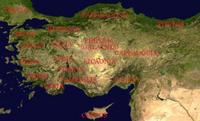 Pupluna/Fufluna - Paphlagónia ?
Pupluna/Fufluna - Paphlagónia ?
Vetluna - Bithünia ?
Caere - Kária?
The name
Paphlagonia probably derives from ancient Luwian or Pala language and its original spelling might have been Pauwa-Lacawana. The peoples of this area were called Paphlagonians by the Greeks and mentioned by Homer in his " Iliad " as being on the side of Trojans. Paphlagonians were one of the earliest peoples who lived in Anatolia in 1st millennium BC. Paphlagonia was heavily colonized by the Greeks and they built number of cities along its coast. Although any local kingdom has never been established here, it was the area, during the Hittite period that the Hittite kings had to deal with its peoples.
A mountainous region, with heavy forests and fertile valleys,
Bithynia acquired its name from the Bithyni, a tribe that had emigrated from Thrace. The country was conquered by Croesus, king of Lydia, in 560 BC and, after the subjugation of Lydia by the Persians four years later...
Caria: The Taurus Mountains extend into the interior region, and the irregular coastline has numerous deep inlets. The islands of Rhodes and Kos lie off the coast. Ancient Greek and Roman historians recorded that the original inhabitants of this region were pushed inland by an influx of people called Carians. The Carians, who were notable as mercenary soldiers, had been driven from their native islands in the Aegean Sea by invading Greeks. The Greeks also established colonies along the coast of Caria, notably Cnidus and Halicarnassus. In the 6th century BC, Caria was incorporated into the kingdom of Lydia; subsequently, it became a Persian dominion, ruled by Carian kings who were subject to Cyrus the Great. Mausolus was the best known of these monarchs...